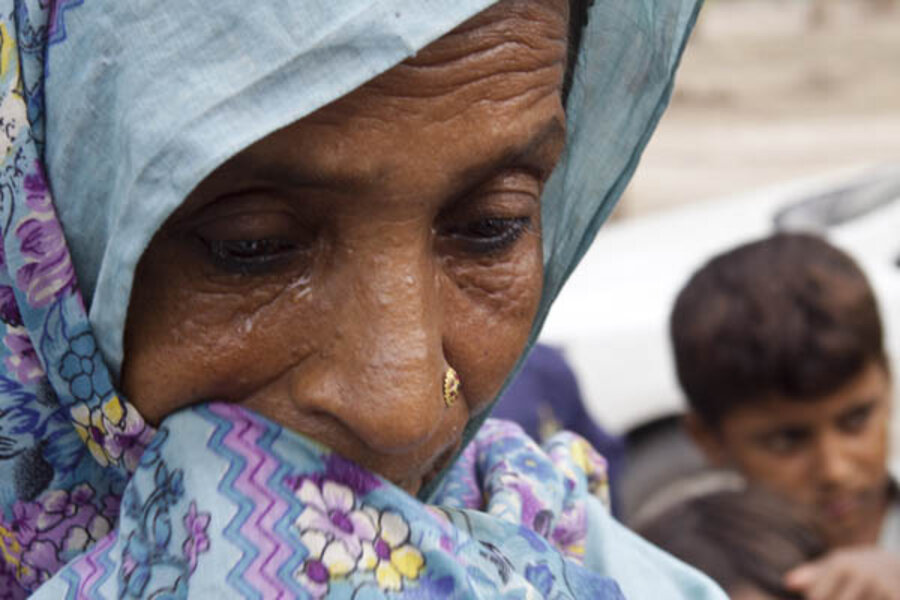Pakistan floods strand the poor while rich go to higher ground
Loading...
| Muzaffargarh, Pakistan
Desperation is growing among those too poor to evacuate this agricultural town in the heart of Pakistan’s Punjab Province, where the worst flooding in 80 years has decimated crops and homes and forced the evacuation of some 250,000 residents, according to the town’s chief official.
As the flood waters continue to spread south, the Pakistani government has issued fresh warnings to towns in southern Punjab and Sindh affected by the overflow of the Indus River, which runs the length of Pakistan, as well as rising levels in the Chenab River, upon which the town of Muzaffargarh is located. Pakistan’s Flood Forecasting Bureau has said that flooding is expected to peak Aug. 14.
The calamity has brought into focus the stark divide between the rich and poor in Pakistan. Those with their own transportation, or the means to hire rented trucks, began leaving the town at the start of the week, and nearly all shops, offices, and banks are now closed. But some 100,000 residents remain homeless and stranded.
No contingency plans
“What can we do? We cannot afford to hire a car or truck and leave, and we have nowhere to go,” says Attia Bibi, a farmer’s wife. Her family has erected a makeshift shelter on a raised dirt track that runs alongside the family’s submerged lands, which they rent from a wealthy landlord. Hundreds of similar tents line the D.G. Khan road, which leads into the main town, and residents say they have no contingency plans for further flooding.
The town's chief official, District Coordination Officer Farasat Iqbal admits the local government has its hands full but says that food is reaching most residents. "Some people are exaggerating their problems," he says, and insists that people should try to reach one of the 20 camps that the government set up in public buildings throughout the greater Muzaffargarh region.
Though the Army has plugged a number of barriers that protect it, the town is not yet out of danger from secondary flash floods. “The next 24 hours are a crucial period. There is a danger that our operation base – the main town center – could be gone,” Mr. Iqbal says.
Most of the crops in the district’s western areas have been submerged and fields will take months to recover, he says, while the city’s thermal power plants were also evacuated. According to United Nations estimates, up to 1.4 million acres of agricultural land in Punjab has so far been destroyed, and Pakistan’s Finance Ministry said earlier this week that the floods would hit Pakistan’s growth target of 4.5 percent this year.
Children awaiting rescue
On Friday, dozens of Muzaffargarh residents were still waiting anxiously for the return of a group of schoolchildren who have been left stranded at a middle-school in the Baseera area of town.
Bashir Hussain, a schoolteacher who is staying with his family at a school building in the main town limits, told the Monitor that two of his nephews and a niece between 3 and 7 years old were still awaiting rescue by Army helicopters five days after flood waters surrounded their school.
“We have sent another one of my nephews who was able to swim across and he is now looking after them, but they are scared and want to come home,” Hussain said as Army helicopters continued to fly overhead and airlift out children and teachers one at a time. The children are surviving on food dropped by air.
Philanthropy in Pakistan
The need for greater assistance is growing clearer by the hour as residents in flood-affected areas complain of seeing little or no help from the government or aid agencies.
At the makeshift tents that line the roads leading into Muzaffargarh, the poor beg passers-by for food and say their children are going hungry.
“The government hasn’t sent us anything. Rich people, the factory owners, send us some rice and bread once or twice a day,” says laborer Abdul Rasheed. “It’s been five days and still no word from the government.”
Philanthropy is common among urban Pakistanis. Civil society groups in major cities often organize their own relief efforts because they do not trust the government or aid agencies. "We don't donate to the government because we know it's mainly a way for government officials to make money," says Amanullah Kariapper, a software engineer based in Lahore, who has organized a group of college students to collect aid and open a camp for the homeless in the village of Shedani in southern Punjab.
With the advent of the Islamic holy month of Ramadan, sharply rising food prices are also adding to people's worries. Prices of basic food items like onions, tomatoes, and potatoes have tripled or quadrupled at times.
On Wednesday, United Nations humanitarian chief John Holmes launched an appeal for $459 million to provide immediate help to millions of flood victims. The disaster has claimed some 1,600 lives and affected up to 14 million people.


